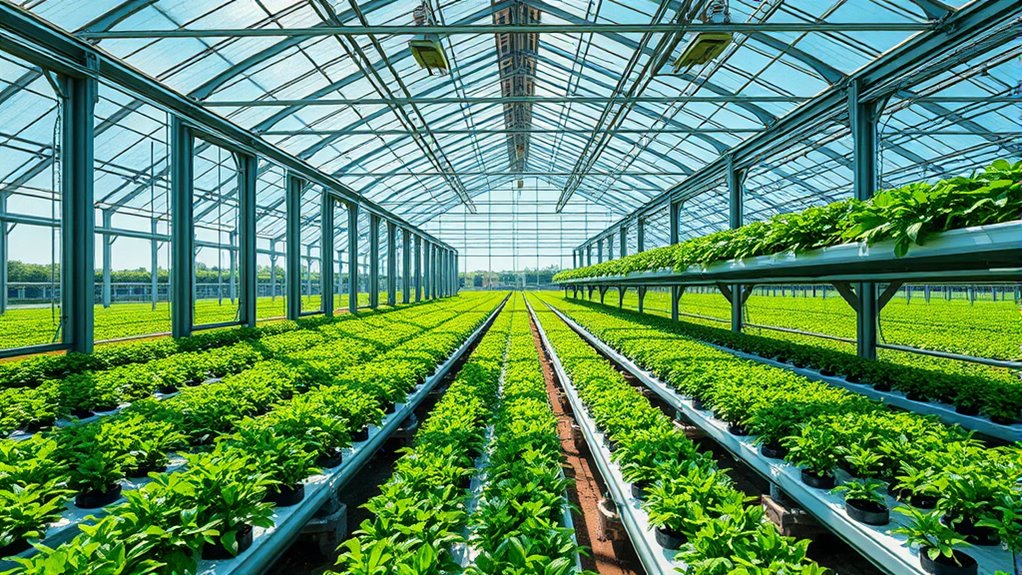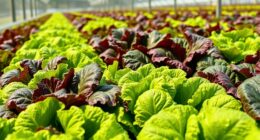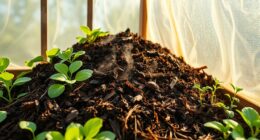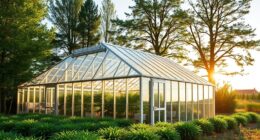If I were looking for the 13 best industrial greenhouse designs, I'd focus on options that maximize growing potential while being climate adaptable and energy efficient. Designs should incorporate passive solar heating, effective ventilation systems, and quality materials for durability. Features like modular structures and automated irrigation can optimize space and resources. I've found that evaluating these factors can lead to significant long-term savings. Stick around to discover more insights that can elevate your greenhouse project!
Key Takeaways
- Utilize climate adaptability strategies like passive solar heating and effective ventilation to enhance growing conditions in industrial greenhouses.
- Incorporate durable structural materials that provide insulation and corrosion resistance for long-term sustainability and efficiency.
- Optimize space through vertical utilization and modular designs to maximize crop production within limited areas.
- Implement automated irrigation and drainage systems, including rainwater harvesting, for efficient water management and sustainability.
- Integrate pest management solutions, such as beneficial insects and physical barriers, to maintain a healthy greenhouse ecosystem while minimizing pesticide use.
The Year-Round Solar Greenhouse Guide

If you're someone who wants to grow vegetables and plants year-round, then "The Year-Round Solar Greenhouse Guide" is perfect for you. I found this book engaging and informative, covering various building methods that extend growing seasons. While it may not dive deep into every technique, it offers practical advice that helped me feel confident about constructing my own greenhouse. I especially appreciated the innovative concepts, like the underground piping system that enhances functionality. The diagrams and case studies enrich the reading experience, and I can't wait to explore the additional resources it suggests for deeper learning.
Best For: Individuals interested in growing plants and vegetables year-round, especially those who are handy and willing to explore innovative greenhouse designs.
Pros:
- Engaging and well-written, making it an enjoyable read.
- Provides practical advice and innovative concepts for greenhouse construction.
- Includes diagrams and case studies that enhance understanding and application.
Cons:
- May lack detailed implementation guidance for some techniques.
- Some readers desire deeper exploration of specific topics.
- Best suited for those who are already handy or have some building experience.
Black & Decker Complete Guide to DIY Greenhouses

For anyone looking to plunge into the world of greenhouse construction, "Black & Decker The Complete Guide to DIY Greenhouses" stands out as an invaluable resource. It covers everything from building greenhouses to cold frames, with clear construction techniques and extensive color photography. I found its practical advice and detailed plans incredibly helpful, especially when designing my own projects. The variety of designs accommodates different needs, but remember to double-check measurements for accuracy. This guide not only enhances your greenhouse experience but also provides insights into other garden structures, making it a must-have for any gardening enthusiast.
Best For: Gardening enthusiasts and DIYers looking to build their own greenhouses or garden structures with comprehensive guidance and detailed plans.
Pros:
- Comprehensive resource for building greenhouses, cold frames, and other garden structures with clear construction techniques.
- Extensive color photography enhances understanding and provides visual inspiration for projects.
- Variety of designs accommodates different sizes and needs, catering to both small and larger setups.
Cons:
- Some users reported inaccurate dimensions for specific projects, highlighting the need for careful measurement verification.
- Focused primarily on greenhouse construction, which may not cover advanced gardening techniques or plant care in depth.
- While extensive, some users may find the information overwhelming, especially if they are new to DIY projects.
How to Build Your Own Greenhouse: Designs and Plans

Building your own greenhouse can be an exciting project, especially for DIY enthusiasts looking for professional-quality structures. I recommend a thorough resource that covers everything from basic designs to advanced concepts. It's perfect for all skill levels, addressing issues like humidity and material selection. If you're interested in aquaponics, the book offers brief insights on integrating fish and plants. Whether you want a simple cold frame or a sophisticated setup, this guide provides valuable tips on extending your growing season and retrofitting systems. Explore this resource alongside others to truly maximize your greenhouse potential.
Best For: This book is best for DIY builders of all skill levels looking to construct professional-quality greenhouses tailored to various climates and plant types.
Pros:
- Provides comprehensive design considerations and practical guidance for a wide range of greenhouse projects.
- Addresses common challenges such as humidity management and material selection, ensuring informed decision-making.
- Offers valuable insights for integrating aquaponics and retrofitting existing structures for enhanced functionality.
Cons:
- Some readers may find the detailed information overwhelming for simple greenhouse projects.
- Limited coverage of aquaponics may not satisfy those seeking in-depth knowledge on the subject.
- Requires a commitment of time and effort to fully benefit from the extensive content provided.
Greenhouses & Garden Sheds: Inspiration & Step-by-Step Projects

Those enthusiastic to immerse themselves in the world of greenhouse gardening will find "Industrial Greenhouse Designs" to be an invaluable resource. This book covers everything from greenhouse positioning to internal layouts and essential heating and lighting systems. Its user-friendly approach makes it perfect for beginners, thanks to clear language and helpful diagrams. I love how the visual content sparks my creativity, showcasing practical ideas for both greenhouses and garden sheds. While it might not explore advanced techniques, its extensive guidance is solid. Overall, I'd rate it an 8 out of 10 for anyone looking to enhance their gardening experience.
Best For: This book is best for beginners and amateur gardeners looking to build or enhance their greenhouse and garden shed experiences.
Pros:
- User-friendly with clear language and helpful diagrams, making it accessible for novices.
- Comprehensive coverage of essential topics like positioning, structure design, and plant care.
- Visual appeal with inspiring photos and practical ideas that stimulate creativity in gardening projects.
Cons:
- Lacks detailed guidance in pictures and intricate instructions for advanced techniques.
- May not satisfy experienced gardeners seeking in-depth information.
- Some readers might require additional resources for more complex greenhouse projects.
Glasshouse Greenhouse: Haarkons world tour of amazing botanical spaces

If you're someone who finds joy in exploring the lush beauty of botanical gardens, "Glasshouse Greenhouse: Haarkon's world tour of amazing botanical spaces" is a must-have. I was thrilled to get this fabulous book after following Haarkon on Instagram, and it exceeded my expectations. The photography immerses you in the enchanting world of plants and whimsical architecture, capturing stunning details. It inspired me to explore lesser-known gardens in Australia and rekindled my passion for botanical spaces during lockdown. With a personal touch from the authors, this book isn't just a coffee table piece; it's an invitation to adventure.
Best For: Anyone passionate about plants, botanical gardens, and whimsical architecture seeking inspiration and adventure through stunning photography.
Pros:
- Beautiful and immersive photography that captures both broad landscapes and intricate details.
- Inspires exploration of lesser-known botanical gardens, particularly in Australia.
- Offers a personal touch from the authors, enhancing the reading experience beyond a typical coffee table book.
Cons:
- May not appeal to those who aren't particularly interested in plants or botanical spaces.
- Some readers might find the focus on specific locations limiting if they prefer a broader range of gardens.
- Could be considered pricey for those looking for a straightforward guide rather than an artistic experience.
Greenhouse Gardeners Companion: Growing Food & Flowers in Your Greenhouse

For anyone looking to maximize their greenhouse gardening experience, the "Greenhouse Gardeners Companion" stands out as an essential guide. It's packed with practical advice on operating your greenhouse, covering everything from air circulation to artificial pollination. I love how it breaks down plant requirements, helping me choose the right vegetables and flowers for my space. The clear instructions and troubleshooting tips make it easy to navigate challenges. Although some readers wish for more climate-specific methods, I've found it invaluable for year-round gardening. This book has truly transformed my growing potential, and I keep it close for daily reference.
Best For: Novice and experienced gardeners looking to enhance their greenhouse gardening skills with practical guidance and detailed plant information.
Pros:
- Offers comprehensive advice on greenhouse operation, including air circulation and artificial pollination techniques.
- Clearly outlines specific plant requirements, making it easier to choose suitable vegetables and flowers for greenhouse conditions.
- Provides troubleshooting tips and money-saving strategies, enhancing the overall gardening experience.
Cons:
- Some readers desire more focus on climate-specific greenhouse methods, particularly for unique environments like deserts.
- Suggestions for general bedding layouts and companion planting could improve the book's comprehensiveness.
- A few users may find the depth of information overwhelming if they are looking for a quick-start guide.
Greenhouse Gardening: The Ultimate Beginner's Guide to Growing Edibles Year-round

Greenhouse gardening offers a fantastic opportunity for anyone looking to grow fresh edibles year-round, especially beginners enthusiastic to plunge into the world of plants. While some resources like "Greenhouse Gardening" claim to guide newcomers, I found it a bit lacking. The book's simplistic approach and poor writing quality didn't engage me. Many chapters cover only basic concepts, which might leave serious hobbyists wanting more depth. If you're an absolute beginner, this book might serve as a starting point, but don't expect advanced techniques. I recommend exploring additional resources to truly maximize your greenhouse potential. Happy gardening!
Best For: Absolute beginners or younger audiences, such as high school agriculture students, looking for a simple introduction to greenhouse gardening.
Pros:
- Provides a basic introduction to greenhouse gardening concepts.
- Easy to read format with large print and double spacing.
- May serve as a helpful resource for those completely new to gardening.
Cons:
- Lacks depth and advanced techniques for serious hobbyists.
- Poor writing quality, including grammatical and spelling errors.
- Minimal information and simplistic content may disappoint more experienced gardeners.
GREENHOUSE GARDENING FOR BEGINNERS: Complete Guide to Growing Vegetables and Fruits

Looking to immerse yourself in greenhouse gardening but feeling overwhelmed? I totally understand! This complete guide is perfect for beginners like you, enthusiastic to grow vegetables and fruits. It explains the purpose of greenhouse gardening, helping you extend your growing season and save money on produce. You'll learn how to select the right greenhouse, whether to build or buy, and maintain it effectively. The detailed crop guides are invaluable too. Just remember, while some find it basic, it's designed for absolute novices. Plunge in, and soon you'll be enjoying your own homegrown harvest!
Best For: Beginners who are new to greenhouse gardening and eager to learn how to grow their own vegetables and fruits.
Pros:
- Provides essential information on selecting, building, and maintaining a greenhouse.
- Includes detailed crop guides for popular greenhouse plants.
- Aims to save money by enabling year-round production of fruits and vegetables.
Cons:
- May be too basic for those with some prior gardening experience.
- Contains issues with quality, including lack of proofreading and unclear statements.
- Focuses more on commercial setups, which may not cater to casual home gardeners.
Stupell Industries Vivid Flower Blooms Canvas Wall Art

Stupell Industries Vivid Flower Blooms Canvas Wall Art is perfect for anyone wanting to infuse their space with the beauty of nature. Designed by Alpenglow Workshop, this stunning piece showcases vibrant flowers and greenery, making it a fantastic addition to any greenhouse or garden-themed room. Available in multiple sizes, from standard to oversized, it fits beautifully in various spaces. The quality craftsmanship guarantees longevity, with high-quality inks printed on durable canvas, hand-stretched over a sturdy frame. Plus, it's ready to hang right out of the box, so you can quickly enjoy its charm without any hassle.
Best For: Individuals looking to enhance their home decor with vibrant, nature-inspired artwork that complements garden or greenhouse themes.
Pros:
- High-quality materials ensure durability and longevity of the artwork.
- Available in multiple sizes to fit various spaces and preferences.
- Ready to hang, providing a hassle-free installation experience.
Cons:
- Best Sellers Rank indicates it may not be widely recognized compared to other popular art pieces.
- Limited design options, focusing primarily on floral and plant themes.
- No batteries or electronic features, which may deter some buyers looking for interactive art.
Stupell Industries Welcome to My Sanctuary Wall Plaque

For anyone wanting to create a serene, plant-filled sanctuary, the "Welcome to My Sanctuary" wall plaque by Stupell Industries serves as a perfect accent. Designed by Louise Allen, this plaque measures 15 x 10 inches and weighs just 2 pounds, making it easy to hang or lean against a wall. Its high-quality lithograph print is mounted on sturdy MDF wood, finished with a fresh layer of foil for a polished look. With clear corners for protection during shipping, it arrives ready to display. This plaque not only enhances my space but also brings a warm, inviting vibe to my greenhouse.
Best For: This wall plaque is best for anyone looking to enhance their home or greenhouse with a touch of warmth and a botanical theme.
Pros:
- Stylish design by Louise Allen adds an elegant touch to any space.
- Lightweight and easy to hang or lean against a wall without additional hardware.
- High-quality materials ensure durability and a polished finish.
Cons:
- Limited size may not be suitable for larger wall displays.
- Only available in one design, limiting personalization options.
- Some may find the price point higher compared to similar products.
The Decorated Garden Room: Interior Design for Your Outside Living Space

Are you dreaming of transforming your outdoor space into a stunning retreat? "The Decorated Garden Room: Interior Design for Your Outside Living Space" offers an array of imaginative ideas and practical solutions for anyone enthusiastic to enhance their garden aesthetics. I fell in love with this book after seeing it at a friend's house. It's filled with beautiful pictures and wonderful ideas that inspire me to rethink my garden. While I've read mixed reviews, I find the practical tips incredibly helpful. If you're seeking something a little out of the ordinary, this book might be just what you need!
Best For: Those looking to creatively enhance their outdoor living spaces with unique design ideas and practical solutions.
Pros:
- Beautifully illustrated with imaginative designs that inspire garden transformation.
- Offers practical ideas that can be easily implemented in your own outdoor space.
- Provides a variety of ideas, making it suitable for individuals seeking something a little out of the ordinary.
Cons:
- Some readers find the content outdated and not applicable to their personal garden preferences.
- Mixed reviews indicate that not all ideas may resonate with every reader.
- A few users feel that the book lacks modern trends in garden design.
GreenGiggle 4 Tier Mini Greenhouse for Indoors or Outdoors

The GreenGiggle 4 Tier Mini Greenhouse is perfect for anyone looking to maximize their gardening potential, whether indoors or outdoors. Measuring 27 by 19 by 62 inches, it fits snugly in tight spaces while offering ample room with four sturdy shelves. I love the clear PVC cover and roll-up zipper door, which help maintain humidity for my tropical plants and seedlings. Plus, it's lightweight and easy to assemble without any tools, making it simple to move around. Just be cautious with heavier plants; they might sag. Overall, it's a fantastic addition to any gardening setup.
Best For: Garden enthusiasts seeking an efficient and space-saving greenhouse solution for indoor or outdoor use.
Pros:
- Easy tool-free assembly and lightweight design for portability.
- Clear PVC cover and roll-up zipper door enhance humidity control for optimal plant growth.
- Four sturdy shelves with a capacity of 33 lbs each, ideal for various plants and gardening setups.
Cons:
- Some users report sagging shelves when holding heavier plants.
- Limited space between shelves may not accommodate larger pots or trays.
- The PVC cover may require careful handling to avoid tears or damage.
Outdoor Portable Walk-in Greenhouse with 2 Tiers and 8 Shelves

If you're looking for an affordable yet spacious solution for your gardening needs, the Outdoor Portable Walk-in Greenhouse with 2 Tiers and 8 Shelves is an excellent choice. With dimensions of 57L x 57W x 77H inches, it's lightweight at just 21 lbs. Built with a heavy-duty steel frame and a PE cover, it guarantees stability and allows light for photosynthesis. I love the ample shelving space, perfect for my plants and tools. Plus, the roll-up zippered door makes access easy. Just be sure to secure it against strong winds for the best experience!
Best For: Gardeners looking for a portable and spacious greenhouse solution for indoor or outdoor use.
Pros:
- Ample shelving space with 8 shelves across 4 tiers for organizing plants and gardening tools.
- Easy assembly with no tools required, making setup straightforward and convenient.
- Great heat retention capabilities, promoting plant growth by keeping them warm and moist.
Cons:
- Zipper issues reported by some users, which may affect ease of access.
- Cover quality concerns, with recommendations for additional reinforcement in windy conditions.
- Stability during strong winds may require securing with extra weights or structures.
Factors to Consider When Choosing Industrial Greenhouse Designs

When choosing an industrial greenhouse design, I always consider several key factors that can make or break my project. Climate adaptability, structural materials, and energy efficiency are just a few areas that can greatly impact success. Plus, optimizing space and ensuring proper irrigation and drainage are essential for maximizing productivity.
Climate Adaptability Strategies
Choosing the right industrial greenhouse design involves considering various climate adaptability strategies to guarantee ideal growing conditions year-round. I've found that incorporating passive solar heating techniques, like orienting the structure to capture maximum sunlight and using thermal mass materials, is essential. Effective ventilation systems are also vital; automated roof vents and exhaust fans help regulate temperature and humidity levels. Insulation plays a key role, too—double-layer polycarbonate panels can greatly reduce heat loss during colder months. Additionally, implementing rainwater harvesting systems optimizes water resources for irrigation during dry spells. Finally, integrating environmental control systems allows me to monitor and adjust conditions, ensuring my plants receive the perfect light, temperature, and moisture throughout the year.
Structural Materials Selection
While evaluating the ideal structural materials for my industrial greenhouse, I focus on factors like durability, insulation, and sustainability. I often lean towards aluminum or galvanized steel frameworks, as they resist corrosion and can withstand harsh weather. The choice of glazing material is equally important; I consider polycarbonate or glass for their excellent light transmission and insulation properties, which help maintain optimal temperatures for plant growth. I also think about the weight and structural integrity of these materials to guarantee they can handle wind, snow loads, and seismic activity. Finally, I prioritize eco-friendly options to minimize environmental impact, as sustainability plays an essential role in my greenhouse design and overall efficiency.
Energy Efficiency Techniques
After selecting the right structural materials for my industrial greenhouse, I turn my attention to energy efficiency techniques that can considerably enhance its performance. Utilizing thermal mass materials like concrete or water helps store heat during the day and release it at night, improving energy efficiency. I also focus on passive solar heating by strategically orienting the greenhouse and using appropriate glazing materials to maximize sunlight exposure, which cuts down heating costs. Installing automated roof vents and side windows optimizes air circulation, reduces humidity, and minimizes energy consumption. Employing insulation techniques, such as double-layered polyethylene, reduces heat loss, while integrating solar panels provides sustainable power for my heating, cooling, and lighting needs, further boosting efficiency.
Space Optimization Methods
When it comes to designing an industrial greenhouse, effective space optimization is essential for maximizing productivity. I've found that utilizing vertical space with multi-tier shelving systems can greatly increase plant density while maintaining ideal growth conditions. Modular designs are a game-changer, allowing me to adapt layouts based on crop types and seasonal changes, ensuring efficient space use year-round. Incorporating movable bench systems enhances my ability to reconfigure the growing area, maximizing light exposure and airflow while easing maintenance access. High-density planting techniques help boost productivity by carefully arranging plants to minimize waste. Finally, integrating technologies like hydroponics or aquaponics optimizes space by eliminating traditional soil beds, allowing for greater crop diversity in limited areas.
Irrigation and Drainage Systems
Maximizing space in an industrial greenhouse is just the first step; effective irrigation and drainage systems are equally important for ensuring plant health and productivity. I've found that using drip or subsurface irrigation can drastically reduce water waste while delivering just the right amount of moisture for ideal growth. It's essential to design drainage systems that prevent waterlogging, which can lead to root rot and other diseases. I also recommend integrating rainwater harvesting systems to create a sustainable irrigation source. Automated irrigation with sensors and timers enhances water efficiency based on real-time soil moisture levels. Finally, properly designed drainage channels and gutters manage water flow, prevent structural damage, and keep the environment clean by minimizing standing water.
Pest Management Solutions
Pest management is a critical factor in designing an industrial greenhouse that thrives. By implementing integrated pest management (IPM) strategies, I can reduce pesticide use by up to 50%, promoting sustainability. Utilizing beneficial insects like ladybugs and lacewings effectively controls pest populations without harming non-target species, which helps maintain a balanced ecosystem. Regular monitoring and scouting for pests allow me to detect issues early, preventing significant infestations and crop damage. Additionally, using physical barriers such as insect netting keeps pests out while ensuring proper ventilation and light. Finally, incorporating biopesticides derived from natural organisms provides safe and effective pest control options, protecting both the environment and the beneficial organisms I want to keep thriving in my greenhouse.
Ventilation and Airflow Design
How can I make certain ideal growing conditions in my industrial greenhouse? Effective ventilation is key. I focus on designs that utilize natural ventilation systems, like roof vents and side openings, to keep energy costs down while allowing cooler air in and hot air out. I also strategically place fans to enhance airflow, ensuring even heat distribution and minimizing stagnant air pockets that can stress plants. I keep wind direction in mind when designing my greenhouse, as proper placement can greatly boost natural ventilation and protect the structure. Finally, I consider incorporating automated ventilation controls, which adjust airflow based on real-time environmental data, promoting healthier growing conditions throughout the year.
Cost-Effectiveness Analysis
Creating ideal growing conditions through effective ventilation is just one piece of the puzzle when it comes to industrial greenhouse designs. I've learned that cost-effectiveness analysis is essential in choosing the right design. You need to weigh the initial construction costs against potential long-term savings from reduced energy use and higher crop yields. The materials and methods you select can drastically affect both upfront and ongoing expenses, so durability and insulation are important. While automated climate control systems may require a higher initial investment, they often lead to significant savings by optimizing resources and lowering labor costs. Don't forget to explore government incentives for sustainable practices; they can make certain designs more financially appealing over time.
Frequently Asked Questions
What Materials Are Best for Constructing an Industrial Greenhouse?
When I think about constructing an industrial greenhouse, I focus on materials that'll guarantee durability and efficiency. I've found that galvanized steel is great for the frame because it's strong and resistant to rust. For the glazing, polycarbonate panels offer excellent insulation and light diffusion. I also like using concrete for the foundation, as it provides stability. Ultimately, choosing the right materials can make a huge difference in the greenhouse's performance.
How Do I Manage Pests in an Industrial Greenhouse?
Managing pests in my industrial greenhouse involves a few key strategies. I regularly inspect plants for any signs of infestation and maintain cleanliness to prevent outbreaks. I also use beneficial insects, like ladybugs, and introduce organic pesticides when necessary. Crop rotation helps break pest cycles, and I guarantee good airflow to reduce humidity, which attracts pests. Staying proactive is essential, and I always monitor my plants closely for any changes.
What Is the Average Lifespan of an Industrial Greenhouse?
Think of an industrial greenhouse as a wise old tree, standing tall through the seasons. In my experience, the average lifespan of an industrial greenhouse ranges from 10 to 30 years, depending on materials and maintenance. Just like nurturing that tree, I've learned that regular upkeep can extend its life. Proper ventilation, structural integrity, and timely repairs can help my greenhouse thrive, allowing me to reap the benefits of my hard work for years to come.
How Can I Optimize Heating and Cooling in My Greenhouse?
To optimize heating and cooling in my greenhouse, I focus on proper ventilation and insulation. I install adjustable vents and fans to improve air circulation, and I use thermal screens to retain heat during colder months. Additionally, I monitor temperatures regularly and adjust my heating system accordingly. Incorporating shade cloths helps manage excess heat in the summer. These strategies have made a noticeable difference in maintaining a stable climate for my plants.
Are There Specific Regulations for Industrial Greenhouse Operations?
You wouldn't believe the maze of regulations surrounding industrial greenhouse operations! It's like steering through a bureaucratic jungle. I've learned that specific regulations can vary wildly by location, covering everything from zoning laws to environmental impact. I've had to comb through local, state, and federal guidelines to stay compliant. If you're planning to operate one, I highly recommend diving deep into the legal requirements. It's vital to avoid costly pitfalls down the line!
Conclusion
In choosing the right industrial greenhouse design, I've discovered that it's not just about aesthetics; it's about functionality, sustainability, and maximizing our growing potential. Whether we seek innovative structures, efficient layouts, or eco-friendly materials, each choice shapes our journey as gardeners. By embracing the right design, we cultivate not only plants but also our passion for gardening. Let's build spaces that inspire growth, nurture creativity, and expand our horizons, turning our dreams into thriving realities.









